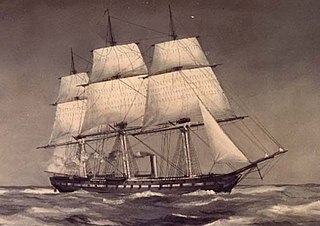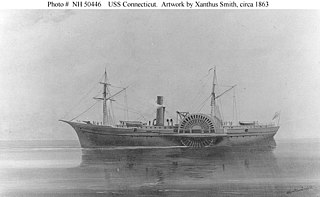
USS New Hampshire (1864) was a 2,633-ton ship originally designed to be the 74-gun ship of the line Alabama, but she remained on the stocks for nearly 40 years, well into the age of steam, before being renamed and launched as a storeship and depot ship during the American Civil War. She was later renamed to USS Granite State.

USS Vermont (1848) was originally intended to be a ship of the line for the U.S. Navy when laid down in 1818, but was not commissioned until 1862, when she was too outdated to be used as anything but a stores and receiving ship.

The first USS Pawnee was a sloop-of-war in the United States Navy during the American Civil War. She was named for the Pawnee Indian tribe.

USS Monongahela (1862) was a barkentine–rigged screw sloop-of-war that served in the Union Navy during the American Civil War. Her task was to participate in the Union blockade of the Confederate States of America. Post-war, she continued serving her country in various roles, such as that of a storeship and schoolship.

USS Wabash was a steam screw frigate of the United States Navy that served during the American Civil War. She was based on the same plans as Colorado. Post-war she continued to serve her country in European operations and eventually served as a barracks ship in Boston, Massachusetts, and was sold in 1912.

USS Seneca was a Unadilla-class gunboat built on behalf of the United States Navy for service during the American Civil War. Seneca was outfitted with guns for horizontal fire as well as with two howitzers for bombardment of shore targets. With her crew of 84, she was assigned to the Union blockade of the Confederate States of America.
The first USS Onward was a clipper in the Union Navy.
USS Rachel Seaman was a wooden schooner purchased by the Union Navy during the American Civil War.

USS Connecticut (1861) was a large steamer acquired by the Union Navy during the American Civil War. Her primary task was to prevent ships from penetrating the Union blockade of Southern ports.
USS Honduras (1861) was a steamer acquired by the Union Navy during the American Civil War.
USS Roebuck (1856) was a barque used by the Union Navy during the American Civil War.

USS Isaac Smith was a screw steamer acquired by the United States Navy during the American Civil War. She was used by the Union Navy to patrol navigable waterways of the Confederate States of America to prevent the Confederacy from trading with other countries. In 1863, she became the only warship in the American Civil War to be captured by enemy land forces. She then served in the Confederate States Navy as CSS Stono until she was wrecked.
USS Fort Morgan (1863) was a steamer acquired by the Union Navy during the American Civil War. She was used by the Navy as a storeship and in other minor roles.

The first USS Wanderer was a high-speed schooner originally built for pleasure. It was used in 1858 to illegally import slaves from Africa. It was seized for service with the United States Navy during the American Civil War. In U.S. Navy service from 1861 to 1865, and under outright U.S. Navy ownership from 1863 to 1865, she was used by the Union Navy as a gunboat, as a tender, and as a hospital ship. She was decommissioned, put into merchant use, and lost off Cuba in 1871.
USS G. W. Blunt was a Sandy Hook pilot boat acquired by the Union Navy during the American Civil War in 1861. See George W. Blunt (1856) for more details. She was used by the Union Navy as a gunboat as well as a dispatch boat in support of the Union Navy blockade of Confederate waterways.
USS Gemsbok (1861) was a bark acquired by the Union Navy during the American Civil War. She was used by the Navy as a gunboat, but, later in the war, she was also used as a collier and as a storeship.
USS Glasgow (1863) was a blockade runner captured by the Union Navy during the American Civil War. She was used by the Union Navy principally as a dispatch boat and storeship in support of the blockade of the ports of the Confederate States of America.
USS Pampero (1853) was a large and capacious ship-rigged vessel purchased by the Union Navy during the American Civil War. She was used by the Navy as a storeship to provision the fleet and as a collier to supply the fleet’s need for coal for their steam engines.
The third USS Union was a heavy (1,114-ton) steamer with a powerful 12-inch rifled gun purchased by the United States Navy during the American Civil War.

The blockade runners of the American Civil War were seagoing steam ships that were used to get through the Union blockade that extended some 3,500 miles (5,600 km) along the Atlantic and Gulf of Mexico coastlines and the lower Mississippi River. The Confederate states were largely without industrial capability and could not provide the quantity of arms and other supplies needed to fight against the industrial north. To meet this need blockade runners were built in Scotland and England and were used to import the guns, ordnance and other supplies that the Confederacy desperately needed, in exchange for cotton that the British textile industry likewise was in desperate need of. To get through the blockade, these relatively lightweight shallow draft ships, mostly built in British ship yards and specially designed for speed but incapable of carrying much cotton, had to cruise undetected, usually at night, through the Union blockade. The typical blockade runners were privately owned vessels often operating with a letter of marque issued by the Confederate States of America. If spotted, the blockade runners would attempt to outmaneuver or simply outrun any Union ships on blockade patrol, very often successfully.









